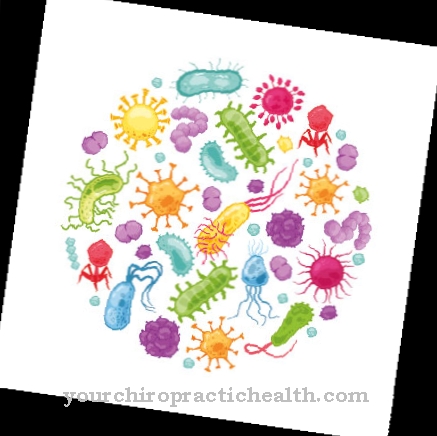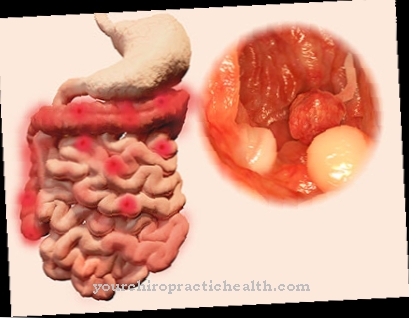The complex regional pain syndrome Sudeck's disease, also Complex Regional Pain Syndrome, CRPS I. called, is a rare form of chronic pain that usually affects an arm or leg. Sudeck's disease typically develops after injuries, surgery, strokes, or a heart attack, with the pain disproportionate to the severity of the initial cause of the disease.
What is Sudeck's disease?

© freshidea - stock.adobe.com 'Sudeck's disease is characterized by continuous burning and throbbing pain, usually in the arm, leg, hand or foot. The characteristics of Sudeck's disease can change over time and vary from person to person.
Sensitivity to touch or cold, swelling of the painful area, changes in skin temperature and color are just a few of the symptoms of Sudeck's disease. Changes in hair and nail growth, joint stiffness, muscle cramps and reduced mobility of the affected part of the body, the condition is often irreversible.
Sudeck's disease can be made worse by emotional stress. In the case of consistently severe pain that only affects the limbs and seems unbearable, a doctor should be consulted, as the chances of recovery from Sudeck's disease increase with timely diagnosis.
causes
It is assumed that Sudeck's disease caused by impaired interaction between the nervous system and inappropriate inflammatory responses. Sudeck's disease comes in two types with similar signs and symptoms but with different causes.
Sudeck's disease type 1 was formerly known as reflex sympathetic dystrophy syndrome and occurs after an illness or injury that did not directly damage the nerves of the affected limb. More than 90 percent of all illnesses belong to this type.
Sudeck's disease type 2 (causalgia) affects a direct injury to the nerves. Many cases of Sudeck's disease occur after severe trauma, such as crush injuries, fractures, or amputations. Other surgical injuries, heart attacks, infections, and even sprained ankles can also trigger the condition.
Symptoms, ailments & signs
Sudeck's disease is usually noticeable in the early stages as inflammatory changes near the originally injured area. The typical signs of inflammation, redness, swelling and overheating, are accompanied by functional restrictions and pain, which can be excessive. As the disease progresses, the intensity of the pain decreases, and those affected are often completely pain-free.
The skin is pale and cool at first, but later it appears remarkably thin. Connective tissue and muscles shrink significantly, the affected joints stiffen: in the worst case, they become completely inoperable. The disease affects sensors, motor skills and the autonomic nervous system in equal measure. Sensory disturbances are expressed as abnormal sensations and impaired body perception in the area of the affected extremity.
Pain can occur both at rest and during exertion and is often triggered by the smallest stimulus such as a light touch. The mobility of the diseased joints is massively restricted, and involvement of the fingers is associated with the loss of fine motor skills.
Due to pain and muscle breakdown, the affected body region can only be subjected to a limited load, movements can be performed with less force. Damage to the autonomic nervous system results in a change in blood flow to the skin and thus a change in skin temperature and color. Edema often forms on the diseased parts of the body, and the growth of hair and nails can be disturbed.
Diagnosis & course
The diagnosis of Sudeck's disease takes place by recording the history of medical treatments and a physical examination. Bone scans can be used to diagnose bone changes in connection with Sudeck's disease.
A radioactive substance is injected into a vein, which enables the bones to be viewed with a special camera. Tests of the sympathetic nervous system include thermography of skin temperature to examine blood flow to the limbs or to measure the amount of perspiration. Deviating results may suggest Sudeck's disease.
Magnetic resonance imaging (MRI) can also document changes in tissue. A good preparation for the medical history to diagnose Sudeck's disease is advisable. For this purpose, all symptoms should be precisely localized with a note of the severity and documented, stating the duration and time intervals.
Complications
Primarily, patients suffer from chronic pain due to Sudeck's disease. In the worst case, this can lead to a stroke or a heart attack, which can also be fatal for the patient. The life expectancy of the person affected is significantly restricted and reduced due to Sudeck's disease.
It is not uncommon for patients to suffer from swelling or reddening of the skin. Itching can also occur on the skin. The extremities of those affected are not infrequently warm, and tremors can also be felt. Muscle cramps can also occur, which are relatively painful. Likewise, patients often suffer from paralysis and sensitivity disorders that can occur in different areas of the body.
Furthermore, pain at night can lead to significant sleep problems and thus to irritation of the patient. The quality of life is significantly restricted and reduced due to the disease. The treatment of Sudeck's disease is usually causal and depends on the underlying disease. Furthermore, the patients are often dependent on taking painkillers. As a rule, it cannot be generally predicted whether this will lead to a reduction in life expectancy.
When should you go to the doctor?
A doctor should be consulted if severe pain occurs over a long period of time after an injury that goes far beyond what is usual for the injury. As a rule, arms or legs are affected, in rare cases Sudeck's disease can develop in other parts of the body.
Sensory disturbances such as burning of the skin, tingling sensation or hypersensitivity to touch should also be presented to a doctor, even with movement disorders such as muscle twitching, muscle weakness, tremors or limited mobility of the affected part of the body, Sudeck's disease requiring treatment must be considered. Other symptoms that should prompt a doctor's visit are water retention and heavy perspiration on the diseased areas - especially if they feel significantly colder or warmer than other areas of the body. Alarm signs can also be accelerated growth of hair and nails in the affected area.
The first point of contact if you suspect Sudeck's disease should be your family doctor. Since the disease cannot always be diagnosed with absolute certainty straight away, referrals are often made to specialists in neurology and orthopedics for further clarification. In the case of severe pain, it is advisable to consult a pain specialist; in severe cases, inpatient treatment can be provided. Psychotherapeutic support is also recommended.
Treatment & Therapy
Starts treatment from Sudeck's disease at an early stage, improvement or remission is possible. An individual combination of different therapies is often necessary. To treat the symptoms of Sudeck's disease, it is helpful to take medication in addition to the therapy.
If simple pain relievers no longer relieve pain, opioid pain relievers may be advisable. In addition to thermal applications, various creams are used in Sudeck's disease to reduce hypersensitivity. Physical therapy reduces pain and improves mobility. Chronic pain can be relieved by applying electrical impulses to the nerve endings (transcutaneous electrical nerve stimulation) or by stimulating the spinal cord.
If treatment is started too late, patients often have to adjust to a life with Sudeck's disease, which can expose the entire living environment to severe stress. In order to cope better with life, relaxation techniques such as biofeedback help, with which those affected develop a better body awareness and can relax more easily. The pain caused by Sudeck's disease can increasingly burden the mental health, here the accompaniment of a therapist is recommended.
You can find your medication here
➔ Medicines for painOutlook & forecast
The prognosis for Sudeck's disease depends largely on how the person concerned deals with the pain. It has been shown that a positive or optimistic attitude towards the curability of the condition significantly improves the prognosis, while preoccupation with the worst consequences leads to a deterioration. It is worth knowing that more than 80 percent of those affected, thanks to a good and diversified therapy, a condition is reached that can no longer be diagnosed as Sudeck's disease. However, the majority of those affected still experience pain, but not impairment of movement.
Multimodal treatment can lead to good results in complex regional pain syndrome within months. It is crucial to maintain the patient's will not to allow himself to be controlled by the often inexplicable disease. The mobility of the affected body region should be preserved. At the same time, pain killers are sometimes used and, thanks to psychotherapy, the patient learns measures that help him to cope with the suffering. The therapy can sometimes take years.
A chronic and severe course that gives those affected by Sudeck's disease a disability is possible. In such cases, the affected part of the body loses its function and therapies are no longer sufficient to restore function.
prevention
Various studies have shown that the risk of Sudeck's disease can be reduced. After a wrist fracture, taking vitamin C supplements daily can reduce the risk of illness. Early mobilization after a stroke can also reduce the risk of Sudeck's disease.
The optimal pain treatment provides a combination of centrally and peripherally acting methods. Invasive pain pumps offer a high degree of autonomy, are virtually non-addictive and make everyday life easier for those affected. This will reduce psychological stress and minimize the perception of pain. Sick people have to learn how to use it first. Non-drug pain therapies also increase well-being, counteract relieving postures and contractures, and ensure relaxation. These include cold and heat applications, massages, TENS, gentle positioning, relaxation exercises or aromatherapy.
Aftercare
In most cases, follow-up care is aimed at those affected and their relatives. Because only with the help of a combined therapy can sufferers better deal with their pain, verbalize their fears and thereby gain tolerance from their environment. The content of aftercare can be, for example, body therapies in which pain-adapted methods of work management or mobility are learned.
Psychological therapies also help sufferers to cope with pain and practice healthy behavior while integrating the pain. Additional therapies such as music, dance, art or autogenic training support chronic pain patients in relaxation and stress reduction, which is expressed in a reduced pain perception.
In an occupational therapy practice, the sick learn to use aids in everyday life in order to be able to make life easier. Physiotherapy supports the lymphatic drainage and prevents lymphatic congestion, which can otherwise lead to increased pain and reduced mobility.
You can do that yourself
If Sudeck's disease is detected early, the symptoms can be alleviated by drug treatment. The patient can support medical therapy by taking natural painkillers.
Naturopathy offers effective preparations such as St. John's wort capsules or teas made from African devil's claw. Various creams are also used to relieve hypersensitivity. The pain can be reduced by targeted massages. Mobility can also be relieved by pressure massages and acupuncture. In consultation with the doctor, methods from Chinese medicine can also be used to alleviate the symptoms. Chronic pain can be relieved with the help of relaxation techniques. Often the attacks subside with calm inhalation and exhalation and the use of essential oils.
Since Sudeck's disease can also affect mental health, it is always advisable to be accompanied by a therapist. The patient should also keep in close consultation with the responsible physician, especially in the event of a severe course or a poor general prognosis. People in whom Sudeck's disease is already well advanced must be treated in a specialist clinic in any case.

.jpg)

























